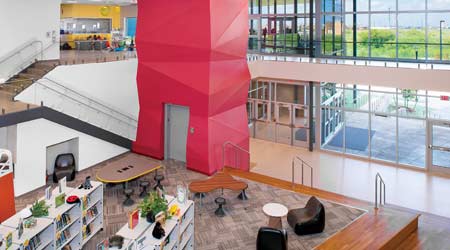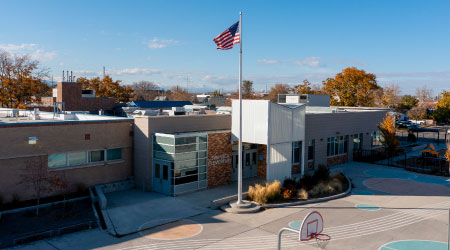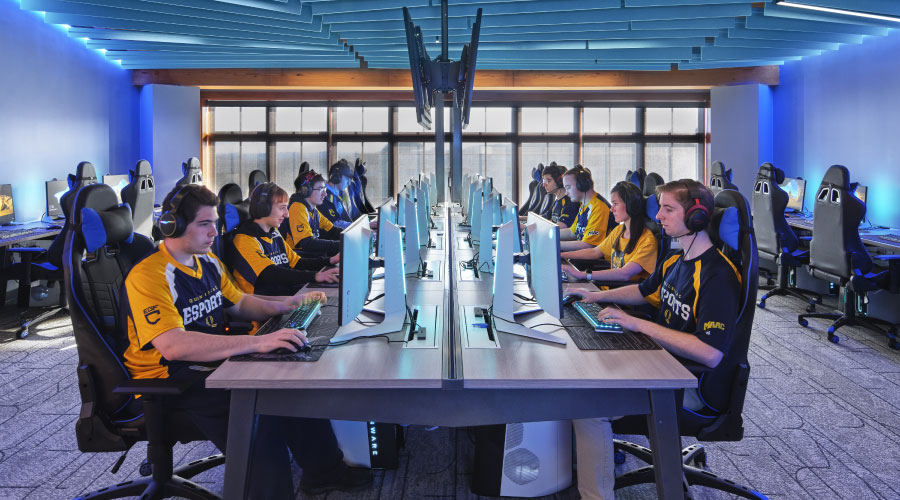 A compact footprint reduces roof area and puts multi-story collaborative spaces in the center. Daylighting through clerestory windows with overhang reduces glare and heat gain.Greg Folkins
A compact footprint reduces roof area and puts multi-story collaborative spaces in the center. Daylighting through clerestory windows with overhang reduces glare and heat gain.Greg FolkinsBeat the Heat: 4 Energy-Saving Design Tips for Hot Climates
For school facilities located in hot climates, cooling loads drive the bus. Here are some tips for reducing energy use.
For decades, K-12 schools have been seeking better ways to design and build sustainable schools, balancing successful building management with learning outcomes. Combine these pressures with a wide range of differing climates, and the design challenges expand significantly.
Within modest budgets and aging facilities, school stakeholders are pressured to realize good returns on community investment while achieving energy savings, reduced costs, and improved occupant wellness alongside student learning. Finding the right balance — economically advantageous, socially responsible, and environmentally friendly — has a positive impact on student and staff satisfaction and the bottom line.
In hot climates, daily cooling loads drive energy use patterns, as schools have the highest occupancy during the hottest time of day. In these conditions, building orientation and massing, strategic glazing, humidity mitigation, and internal heat gain all affect overall cooling requirements.
In addition to the importance of saving energy, there are a range of best practices, many of which are already required by building codes. Some common environmental strategies include water-use reduction, naturalized stormwater management, and using local and recycled material. Other strategies are centered around occupant wellness and quality of life, like healthy air, daylight (which can also conserve energy), and access to amenities like shopping, parks, and public transit.
Designing energy efficient schools in hot climates presents four main challenges: overall footprint and roof area, humidity, window and light ratios, and internal heat gain.
Hot climate strategy #1: Minimize the school’s footprint. Reducing the amount of roof area exposed to radiant sun energy is an increasingly important strategy. As a result, compact multi-story schools are increasingly better solutions, as their smaller footprint reduces roof area and recognizes the high cost of real estate while additionally conserving valuable open space. For many schools, particularly in suburban neighborhoods where land was plentiful, sprawling one-story schools were the norm. Factors to take into consideration when minimizing roof area for energy reduction include choosing a cool roof material that reflects solar energy and the potential area needed now or in the future for renewable energy sources like photovoltaic panels.
Compact schools may also require reconsideration of some program elements. For instance, dining and library programs can support modern learning when recast as commons areas, thereby contributing to a lively, interconnected learning community while allowing the building form to be more compact.
Hot climate strategy #2: Control internal heat gain. When you’re trying to cool the building, additional heat gain is working against you and you may not get the performance you expected. Most schools have migrated away from inefficient lighting to LED, which produce less heat. This is a very positive step. Additional considerations should be planning for realistic occupant loads — because people produce heat — and occupant schedules. So, for example, if schools end up being used for popular camp programs and other initiatives over hot, humid summer months, there may be significantly more energy used for cooling than expected. Lastly, equipment and computers expel heat (while of course also contributing to plug loads). An excellent strategy is to phase out heat-producing desktop computers — which is already happening as the traditional computer lab becomes a thing of the past. As “one-to-one” student to technology programs become more popular, whereby every student gets a device, schools are considering using tablets rather than desktops for ease of portability — but tablets are also cooler (in every sense of the word).
Hot climate strategy #3: Achieve optimal design for window, solar heat gain, daylight, and views. In general, the best strategy is to ensure that classroom windows, and those of other regularly occupied learning areas, are facing either south or north. For south-facing windows, although the sun is often strong from that direction, the light is easier to control with external horizontal sun shading devices (fins) because the sun is higher in the sky — and blinds aren’t required and will not block views. When the sun is lower, like in the east (morning) and west (late afternoon), the light is harder to block without also impeding views outward. North light is diffused and doesn’t require control. Strategic window placement can minimize solar heat gain while harnessing good (free) light and providing beneficial visual connections to nature.
Hot climate strategy #4: Effectively managing humidity. Humidity in hot climates can be especially problematic because it transfers warm vapor into a building, while also potentially causing occupant discomfort (humid air feels hotter than dry air), mold growth (particularly important for students with allergies and sensitive respiratory systems), and material warping and deterioration.
The good news is current building and energy codes are already requiring tighter building envelopes, including features like continuous exterior insulation and air barriers, which greatly reduce humidity transfer to the interior.
Air movement can promote evaporative cooling from the skin even if the air is humid. Operable windows promote natural cooling while giving users more control over their immediate environment. Of course, the use of operable windows must be balanced with allowing more humidity inside. In schools, special sensors can be connected to indicator lights letting student know when the conditions are just right to allow in fresh air. Another option is efficient, low-velocity high-volume fans, which can also move air around without consuming much energy.
Camilo Llorens Bearman (camilo.bearman@stantec.com) is a senior associate with Stantec specializing in learning environments. He has more than 20 years of architecture experience.
Jeff Moroz (jeff.moroz@stantec.com) is a senior associate, architecture with Stantec. He has more than 20 years of experience and leads the firm’s K-12 education studio in Manitoba.
Related Topics:













